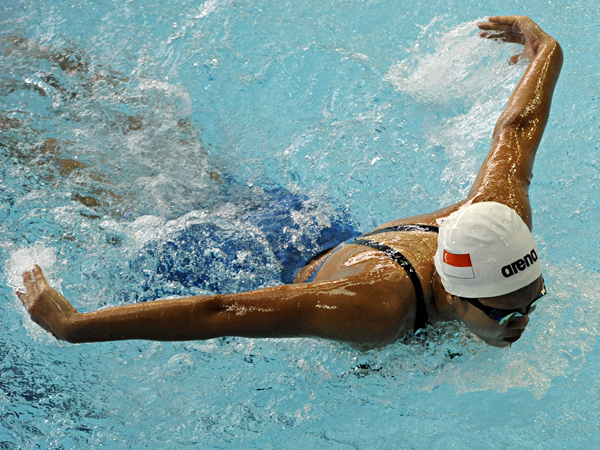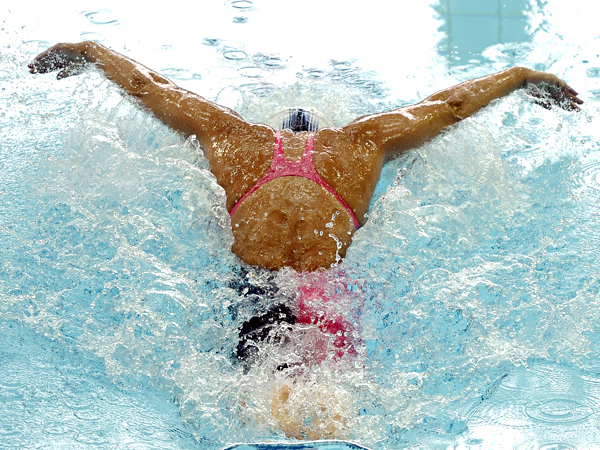How do you swim butterfly stroke?

File Photo Credit: Wong Chek Poh/SportSG
By Malcolm Baey
MASTER YOUR SWIMMING TECHNIQUE (3): BUTTERFLY
The butterfly stroke is one of the most difficult swimming strokes because it requires precise technique in addition to good rhythm. It is arguably the most aesthetically pleasing stroke, a balance between power and grace.
The “fly” as it is affectionately called by swimmers, requires two dolphin kicks followed by simultaneous arm motion. It is extremely rewarding to swim the “fly” so here are 5 easy steps that teach you how to master this technique.
Step 1: Body position
Keep your body flat and lie facing down in the water with your body kept in line with the water surface.
Step 2: Arm movement
Similar to the front crawl, there are three steps in the arm movement - the Catch, Pull and Recovery.
- Catch - With arms out straight, shoulder width apart and palms facing downwards, press down and out at the same time with both hands.
- Pull - Pull hands towards your body in a semicircular motion with palms facing outwards, keeping your elbows higher than your hands.
- Recovery - Once both hands reach the upper thighs at the end of the pull, sweep both arms out and over the water simultaneously and throw them forwards into the starting position. Make sure your palms are facing outwards so your thumbs enter the water first.

Body position when swimming the buttefly (file photo credit: Wong Chek Poh/SportSG)
Step 3: Breathing Technique
Breathing can be challenging as it has to be timed and completed quickly. The correct time to take a breath is during the start of the recovery phase when the arms are just starting to come out of the water. Raise your chin above the water whilst looking straight making sure not to turn to the side.
Step 4: Leg Action
The best way to learn the leg action for butterfly is to imagine yourself as a dolphin or mermaid with only a tail! With both legs together and toes pointed, kick downwards at the same time.
- The first kick is a small one to balance your body position after your arms enter the water
- The second kick is a big one, performed during the recovery phase when your arms are over the water. The big kick is to continue to propel your body forward as momentum is lost during recovery.
Step 5: Move your body in a wave-like fashion
Be one with the wave. Your whole body should have an undulating S-shape as you swim. Similar to dancing, let your instincts take over and go with the flow of the motion. If you manage to pin down your rhythm and synchronize both body movements with your limbs, your strokes will be more efficient and less tiring.
Notes on Coordination
- Use two dolphin kicks to each arm cycle
- The first kick occurs as your hands begin the catch phase
- The second kick occurs at the end of the pulling phase
- Chin down after breathing
Helpful Tips
- Kick from your hips instead of just your legs
- Use the power from the pull to come out of the water to breathe
To receive the latest updates on the happenings in the Singapore sports scene, or to find out more about some of the latest programmes on offer at ActiveSG, like our Facebook page here.





![ActiveSG Academies and Clubs Logo (Solid Colour)[8647]](https://www.activesgcircle.gov.sg/hs-fs/hubfs/ActiveSG%20Circle%202023Theme/images/ActiveSG%20Academies%20and%20Clubs%20Logo%20(Solid%20Colour)%5B8647%5D.png?width=150&height=65&name=ActiveSG%20Academies%20and%20Clubs%20Logo%20(Solid%20Colour)%5B8647%5D.png)




-01.png?width=200&height=141&name=Team%20Singapore%20Logo%20(Red)-01.png)



